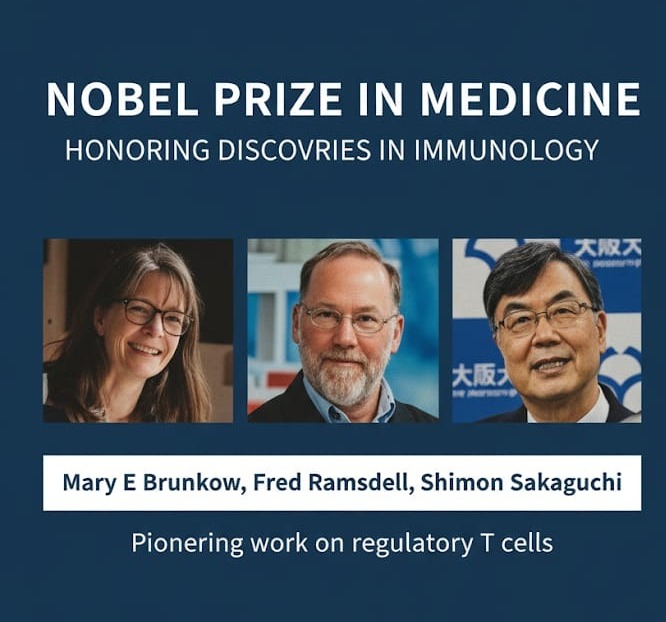
The human immune system is one of biology’s most complex orchestras, performing an intricate balancing act between attack and restraint. Its success determines whether the body can ward off disease without harming itself. This year’s Nobel Prize in Medicine honors three scientists — Mary E Brunkow, Fred Ramsdell, and Shimon Sakaguchi — whose pioneering work uncovered how this delicate system knows when to act and when to stand down. Their discoveries have opened new frontiers in the treatment of cancer, autoimmune diseases, and inflammatory disorders.
Sakaguchi, who hails from Japan, first identified regulatory T cells in the 1990s. His discovery explained why some immune systems mistakenly attack healthy tissue. By showing that a special subset of T cells could suppress excessive immune activity, Sakaguchi provided a new understanding of immune tolerance. Yet, what remained unclear was how these cells functioned and how their activity could be controlled or restored when malfunctioning.
This is where Brunkow and Ramsdell’s research in the United States proved vital. Working at the biotech firm and research foundation ImmuneX, the duo identified a gene named FOXP3 as the key regulator of Treg cell development and function. Without this gene, the body loses its internal immune brakes, resulting in catastrophic autoimmune damage. Their research explained how a single mutation could trigger severe immune disorders, and more importantly, how this pathway could be targeted for therapy.
The Nobel Committee in Stockholm called the trio’s work “a revelation that redefined the boundaries of immunology.” It is a rare instance where fundamental cellular biology has directly translated into practical medicine within a generation. Their discoveries not only clarified why the immune system sometimes turns rogue but also paved the way for drugs that can either suppress or enhance immune activity with precision.
Regulatory T cells serve as the body’s peacekeepers. They prevent the immune system from waging war against itself. These cells act by sending inhibitory signals to effector T cells, which are otherwise programmed to destroy perceived invaders. In the absence of Tregs, the immune response can spiral out of control, leading to autoimmune diseases such as type 1 diabetes, lupus, and multiple sclerosis.
Conversely, in the context of cancer, the same suppressive power of Tregs can be harmful. Tumors often exploit these regulatory mechanisms to hide from immune attack. The challenge for scientists has been to fine-tune this balance — to dampen Treg activity in cancer while boosting it in autoimmune conditions.
The discoveries of Sakaguchi, Brunkow and Ramsdell have led to a surge of therapeutic innovation. Immunotherapies that selectively target regulatory T cells are now under development worldwide. In cancer treatment, drugs designed to neutralize Treg suppression can unmask tumors to immune assault. Meanwhile, in autoimmune disorders, treatments that enhance Treg function promise to calm the body’s mistaken defenses without the blanket immunosuppression that leaves patients vulnerable to infections.
The implications go far beyond medicine. The laureates’ findings have deepened our understanding of biological self-recognition — how the body distinguishes friend from foe. This principle underlies not only immune regulation but also transplantation biology, allergy research, and vaccine design. It is a testament to how curiosity-driven science can transform human health when pursued with patience and precision.
In interviews following the announcement, Sakaguchi credited decades of collaborative work across laboratories and continents. “The immune system is a mirror of human existence,” he said. “It must know when to protect and when to yield. Our task was to uncover how that wisdom is built into our cells.”
Ramsdell and Brunkow echoed the sentiment, emphasizing that their research began with basic questions about immune malfunction in rare genetic diseases. “We did not set out to cure cancer or autoimmunity,” Ramsdell noted. “We were trying to understand why the immune system sometimes fails to recognize its own limits. That pursuit led to everything that followed.”
The Nobel Assembly described their work as a bridge between classical immunology and the emerging science of immune engineering. It also praised their efforts to translate laboratory findings into therapies that could enter clinical trials. The discoveries, the Committee said, “have saved lives, inspired generations of researchers, and provided tools to harness the immune system for good.”
For decades, scientists have known that the immune system’s strength lies in its adaptability. What the laureates proved is that its wisdom lies in restraint. Their findings remind us that biological progress is not always about speeding forward but about learning when to stop.
In an age where scientific headlines often focus on artificial intelligence or genetic editing, this year’s Nobel Prize stands as a quiet celebration of natural intelligence — the intricate design within the human body that has evolved over millions of years to keep us alive. By revealing how our inner sentinels watch over us, the laureates have given humanity not just new cures but a deeper understanding of life itself.





















